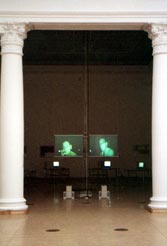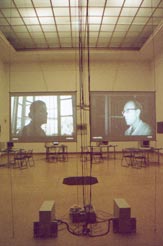Smalltalk
Smalltalk, the creation of Zoltán Szegedy-Maszák, Róbert Langh and Márton Fernezelyi is the emblematic work of the Media Model exhibition. In part, it is an example of intermedial thinking; in part, it is also a model in the strictest sense of the word. The creators perhaps did not plan it beforehand exactly in this way, but the work in its present form is merely the maquette of an artwork to be realised in its finished form in future.
In 1995, John Brockman wrote in his book entitled The Third Culture that a fundamental tendency of our age is the elimination of mediators. The representatives of the new layer of the third culture as named by the author (with the first culture being natural scientists, and the second culture consisting of the social scientists) attempt to express their most significant thoughts in such a way that they be understandable on the part of the viewer or reader of average intelligence. The representatives of the third culture are first and foremost natural scientists which also explains the book publishing boom of the last decade as well, in which brain research, among other fields, plays a role alongside the leading area of interest of astronomy. Publications which previously appeared only in the professional journals in the encoded language of mathematics and psychology have now become popular among the widest of audiences due to the fact that scientists, who wished to free themselves from the institutional and theoretical bonds of science, have now brought their work into the public sphere in popular form.
The reaction of art to this tendency is in the intent of the transmission of natural science research, or in rendering it attainable via a new approach that seeks thematic points of engagement within science. During recent years, the research of the border zones of science and art have once again become the central theme of theoretical literature.
Smalltalk is also interpretable within this relational system, as it consciously, and in an ironic format, employs a scientific approach. Nevertheless, it is thus difficult to perceive it as an artwork because, similarly to a scientific experiment or demonstration, it speaks for itself and the viewer thus receives that which s/he expects on the basis of its description.
From a scientific perspective, the work may best be compared to a haystack stood on its head that somehow remains upright. Taking off from the fundamental theme of Smalltalk, we arrive at the widest range of questions, fanning out along the research topics of contemporary linguistics, psychology, neuroscience, sensory and artificial intelligence. The linguistic line, for instance, engages with the theme of the work of one of the stars of the „third culture“, Steven Pinker, entitled The Language Instinct, which was also published in Hungarian translation in 1999. Pinker states that speech, and language in general, is genetically coded. His concepts stirred up a storm in the professional circles, and the standard of the work also referred to several linguists on the level of widely unfolding discourse. In any case, this book made a great impact, with its comparison of human language-learning, taking its launch from determinist foundations, to the computer, which only must be fed with an appropriate quantity of words in order to develop. The dialogue of the robots in Smalltalk can only proceed in the direction designated by the authors and the software; thus, in this case, a one-sided genetic determination would be too simple a solution. It might also be the interdependence between Turing and Duchamp, the common denominator of the technical-scientific and artistic approaches, cropping up again and again over the course of decades. Turing’s machine has been ranked among the calculating bachelor apparatuses of 20th century culture, practically from the start. The question of whether or not Smalltalk is a bachelor apparatus would be, however, the subject of another sort of investigation. (And one more minor Duchamp parallel: a few days prior to the closing of the exhibition, the glass of the touchscreen serving as interface was broken. I believe that due to this, the authors were unable to pronounce the work completely finished.)
The central motif of the work is the question of the Turing test: Can machines think? Certainly, equally important is the question of whether a conversation between two robots can be considered a work of art.
Zoltán Szegedy-Maszák, who conceived the idea for the project, instead of the usual blind interview, delivers a view, spectacle, to the work. The view is ironic. Manci and Béla, the two chain-smoking robots, appear as the leading characters of an intellectual sci-fi film. The two names refer to the heroic age of Hungarian computer science, surely the reason the authors chose these names for their first robotic creatures. In their resting state, Manci and Béla are just like two calmly smoking robots, swooshing away in their spaceship, whilst the mortal crew have been packed into the neighbouring room to hibernate for fifty years. (The spaceship, meanwhile, is none other than the Chinese room under construction continuously for twenty years by the investigators of consciousness. The Chinese room has a nice balcony too, but its entrance is only a touchscreen.)
If we look closer at the interface, we discover that the interactivity is only an illusion: one cannot really ask a question. The questions are already given. The methods of Blade Runner, Pirx and the other famous adopters of the Turing test run up against a closed system here. One cannot outwit the robots; they themselves are killing time.
Similarly to his earlier works, Zoltán Szegedy-Maszák has here created a world of independent systems, operating according to its own internal rules, in which the viewer receives the illusion of free communication. We communicate with the artist-robots in such a way that we actually make out from their sentences only that which we would also say, or that which we would like to understand.

